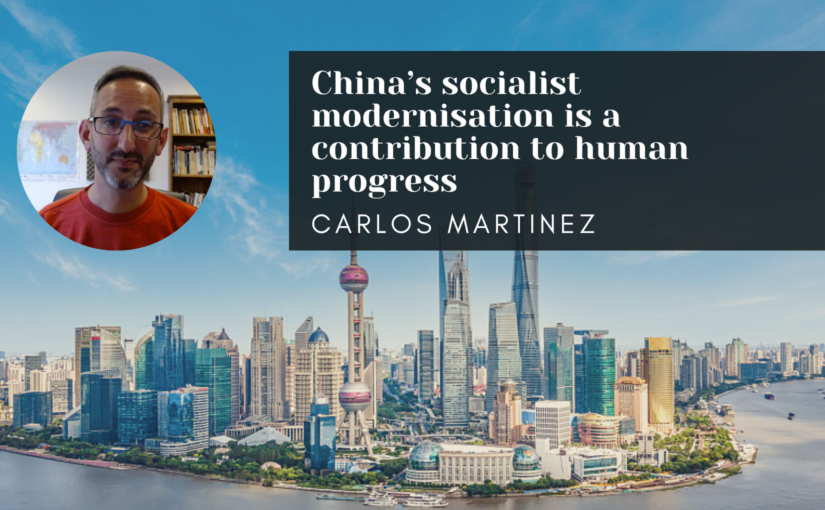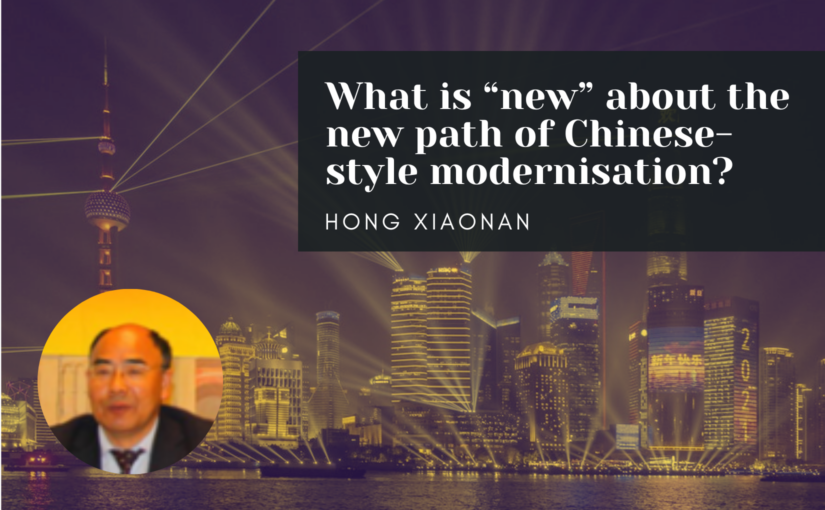Friends of Socialist China co-editor Carlos Martinez was invited by the Chongyang Institute for Financial Studies at Renmin University of China to make a contribution at the thematic symposium on Chinese Governance and Multiple Paths of Modernization at the 5th Hongqiao International Economic Forum, held in Shanghai from 5 to 10 November, 2022.
What follows is the transcript of his remarks, in which he reviews the imperialist countries’ process of modernisation – characterised by colonial violence and plunder – and contrasts this with China’s evolving modernisation path, which is peaceful, sustainable, and based on common prosperity.
All countries have a right to modernisation. Modernisation is a process that enables higher living standards for the masses of the people. It enables common prosperity. With modernised industry, production technique, communication methods, transport systems, energy systems and healthcare methods, humanity has the potential to provide a healthy, meaningful and dignified life to everybody.
A life where each individual has reliable access to a healthy diet, to decent housing, to clothing, to education, to healthcare, to a vibrant cultural, social and intellectual life, to interesting work. In short, modernisation makes it possible to attend to people’s fundamental human rights.
And furthermore, these days it is possible to modernise in a way that doesn’t damage the planet, in a way that doesn’t compromise the sustainability of human existence on Earth.
What China has shown the world is that there is more than one path to modernisation.
For a long time, the predominant ideology – particularly in the West – has affirmed that the only path to modernisation is the one laid down by the imperialist powers.
And what does that path look like? Countries such as the United States and Britain claim that the secret of their success was the combination of free-market capitalism and a system of Western-style parliamentary democracy.
However, there are plenty of countries in the developing world that have attempted to apply that formula and that have achieved little more than chaos.
Indeed, the reality of the West’s path to modernisation looks profoundly different to the picture that has been painted. The industrial revolution, carried out first in Britain, was built to a significant degree on the profits of colonial plunder and the slave trade.
Britain accumulated extraordinary wealth from its colonial ventures in Ireland, India, the Caribbean, the Americas, Africa and elsewhere – not to mention the profits from forcing opium on China, a project so lucrative that Britain went to war multiple times in order to protect it.
It was British, Spanish, Portuguese and French ships that took captured African slaves to the Americas to be worked to death in the plantations, producing sugar, cotton and tobacco for the world market.
Karl Marx famously wrote in Volume 1 of Capital: “The discovery of gold and silver in America, the enslavement and entombment in mines of the aboriginal population, the beginning of the conquest and looting of the East Indies, the turning of Africa into a warren for the commercial hunting of black-skins, signalled the rosy dawn of the era of capitalist production.”
This is the ugly truth of European modernisation. And the story is not so different in the United States. The so-called founding fathers of that country were slave-owners, and they established a slave-owners’ society. They went to war against the indigenous tribes and against Mexico in order to expand their territory.
In the 20th century, having established their domination over the Americas, they constructed a neocolonial global system that is still in place to a significant degree, imposing American hegemony on the world.
A network of 800 foreign military bases. NATO. An enormous nuclear arsenal. Genocidal wars waged on Korea, Vietnam, Yugoslavia, Afghanistan, Iraq, Libya. Systems of economic coercion and unilateral sanctions. Proxy wars, coups, regime change projects, destabilisation.
This is the global system of violence that has facilitated and accompanied imperialist modernisation.
Furthermore, the benefits of this modernisation have been distributed vastly unequally. The wealthy in the US, Britain and elsewhere live an incredibly ‘modern’ life, but there are hundreds of thousands of homeless people; tens of millions that will have to choose between heating and eating this winter; tens of millions that don’t have access to healthcare.
China has also been modernising. China’s modernisation starts in 1949 with the founding of The People’s Republic, the early construction of socialist industry, nationalisation of the land, and the provision of education and healthcare services to the whole population.
In 1963, Premier Zhou Enlai first raised the question of the Four Modernisations: of agriculture, industry, defence, and science and technology. With the launch of reform and opening up in 1978, China accelerated its pursuit of those goals, and ushered in an era of rapid development of the productive forces and improvement in the people’s living standards.
China’s journey of modernisation has evolved again in recent years with the pursuit of the second centenary goal: of building a great modern socialist country that is prosperous, strong, democratic, culturally advanced, harmonious and beautiful by 2049.
China’s modernisation, however, is a socialist modernisation. It’s distinct from the capitalist model of in several important ways:
- It is built on the efforts of the Chinese people rather than on war, colonialism and slavery.
- Its fruits are to be shared by everybody, not dominated by the wealthy. As General Secretary Xi Jinping said in his work report to the 20th National Congress of the Communist Party of China, China’s modernisation is “the modernisation of common prosperity for all.”
- It is becoming a green modernisation, fuelled by clean energy, careful not to destroy the planet that sustains us. Again quoting Xi Jinping’s work report, “it is the modernisation of harmony between humanity and nature.”
This evolving, peaceful, sustainable and fair modernisation constitutes a valuable contribution to our collective human understanding, and shows that there is more than one path to modernisation.
But this did not come about by accident.
China’s achievements, its commitment to common prosperity, its commitment to ending poverty and underdevelopment, its commitment to preventing climate collapse and its commitment to peace are a function of China’s political system, its revolutionary history, and the leadership of the CPC.
While democracy turns out not to have been the essential ingredient in the West’s modernisation, socialist democracy is certainly an essential ingredient of China’s modernisation. Because of China’s revolution and the party’s adherence to the Four Cardinal Principles, power in China is exercised by, and on behalf of, the people – not a small group of wealthy people that own and deploy capital. As such, China’s modernisation serves the people.
China’s ongoing process of socialist modernisation is therefore an inspiration and a valuable lesson to progressive and peace-loving people the world over.


